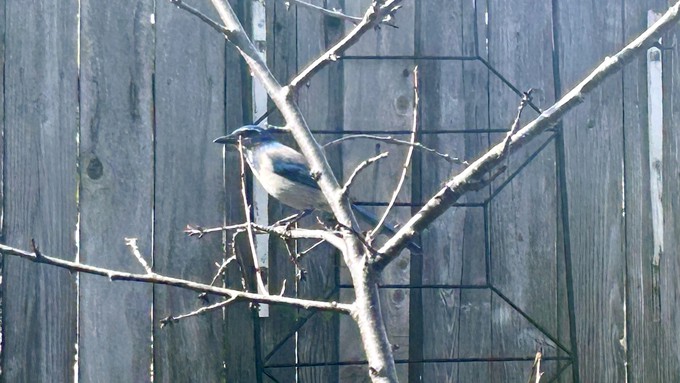
Volunteer birdwatchers of all ages can take part in four-day census

A California scrub jay visits a Carmichael backyard. California last year submitted the most bird lists during the Great Backyard Bird Count, which runs Feb. 16-19 this year. Kathy Morrison
This weekend, grab some binoculars and participate in one of the world’s largest citizen science projects. All it takes is 15 minutes in your own backyard or neighborhood park. And the whole family can get involved.
It’s the Great Backyard Bird Count (GBBC), a four-day snapshot of avian diversity that’s become a worldwide phenomenon. More than 555,000 birders participated in 2023 with expectations of even more this weekend.
Held over the long Presidents’ Day Weekend (Feb. 16 through 19), volunteers of all ages and abilities take part in this census of our feathered friends. Because its emphasis is on backyards and neighborhoods, the count helps build awareness of our suburban wildlife while serving as a measurement of bird diversity since 1998.
To get you started, the organizers are hosting a free webinar via YouTube at 10 a.m. Tuesday, Feb. 13. “Panelists will explain how to participate in this exciting global event and how participation might extend past your back door,” say the hosts. “Discover how to join a group taking part in the GBBC and explore fun ways to involve kids. From bird ID tips to counting birds with ease, this webinar is your ticket to an engaging and confident GBBC experience.”
Sign up for it here: https://www.birdcount.org/
Co-hosted by the Audubon Society and the Cornell Lab of Ornithology, the GBBC is open to birdwatchers anywhere. And it’s free to participate.
The challenge is simple: Count how many birds you see during a 15-minute period (or more) during the four-day event in a specific space, such as your backyard. You also can count birds in a neighborhood park, along a stream or river, or wherever you like. The key: Document what you see including the bird species as well as number.
Handy tools are offered online to help with identification, such as Merlin Bird ID. (It can ID most of your sightings with three easy questions.) Also, take photos to help with that ID process (and to document your observation – experienced bird watchers will review your findings). Then, submit your list of birds to the GBBC using the eBird tool (also available online).
A source of fun and fascination during the COVID lockdown, the bird count has continued to grow.
In 2023, nearly 335,000 checklists were submitted from 202 countries, including 236,904 in the United States. That’s a 34% increase from pre-pandemic 2020.
In the U.S., California submitted the most checklists – 21,585, nearly a 7% increase from 2022.
With more eyes came more diversity of birds. Worldwide, 7,732 bird species – about two-thirds of the planet’s known species – were observed and 7,538 were verified, about 800 more than 2020.
U.S. participants recorded 674 species in 2023. California birders spotted 389 species, the most of any state.
In Sacramento, 660 checklists recorded 170 species, topped by the western screech owl. (Crows, of course, were also very common as well as blackbirds.) Sacramento even had a confirmed bald eagle sighting at the Kiefer landfill.
In the U.S., the birds appearing on the most checklists were distinctive species that are easy to spot (and tend to love bird feeders): Northern cardinal, house finch and dark-eyed junco.
GBBC isn’t limited to home landscapes. Locally, birders reported 70 species along the American River Parkway, one of several local hot spots.
To participate or learn more: https://www.birdcount.org/
Comments
0 comments have been posted.Sacramento Digs Gardening to your inbox.
Sites We Like
Garden Checklist for week of July 21
Your garden needs you!
* Keep your vegetable garden watered, mulched and weeded. Water before 8 a.m. to reduce the chance of fungal infection and to conserve moisture.
* Feed vegetable plants bone meal, rock phosphate or other fertilizers high in phosphate to stimulate more blooms and fruiting. (But wait until daily high temperatures drop out of the 100s.)
* Don’t let tomatoes wilt or dry out completely. Give tomatoes a deep watering two to three times a week.
* Harvest vegetables promptly to encourage plants to produce more. Squash especially tends to grow rapidly in hot weather. Keep an eye on zucchini.
* Pinch back chrysanthemums for bushy plants and more flowers in September.
* Remove spent flowers from roses, daylilies and other bloomers as they finish flowering.
* Pinch off blooms from basil so the plant will grow more leaves.
* Cut back lavender after flowering to promote a second bloom.
* It's not too late to add a splash of color. Plant petunias, snapdragons, zinnias and marigolds.
* From seed, plant corn, pumpkins, radishes, winter squash and sunflowers.